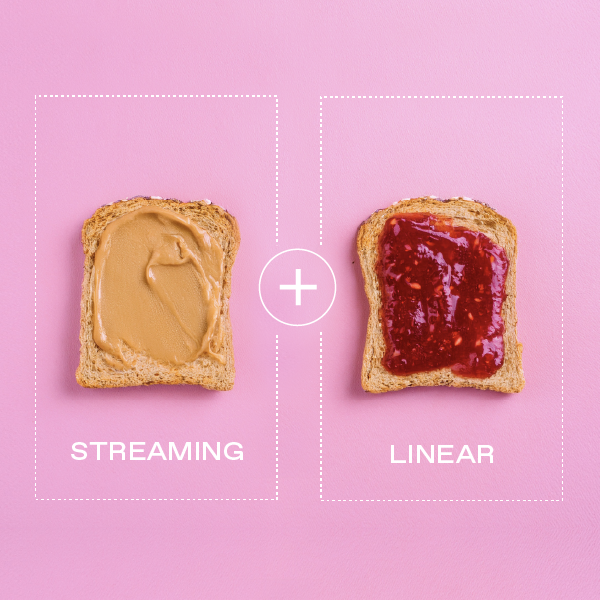
What is CTV? Understanding Connected TV Advertising in 2025
Connected TV (CTV) - or streaming TV - refers to televisions connected to the internet. This allows users to stream content through streaming platforms such as Hulu, Peacock, Netflix, and YouTube. This connectivity opens up a powerful channel for advertisers to reach highly engaged viewers in their living rooms or wherever they interact with their smart phones as connected TV advertising can deliver personalized, data-informed ads that rival the precision of digital campaigns.
“Connected TV (CTV) bridges the gap between traditional broadcasting and digital precision, revolutionizing how brands reach audiences.”
-Epsilon | Lotame, Top CTV Advertising Trends & Predictions from NewFronts 2025
If you've ever seen an ad while watching Hulu on a Roku, or streamed a program on Peacock, you've already experienced CTV advertising firsthand. In 2025, this format is not only mainstream—it's essential for marketers who want to stay competitive in a fragmented, digital-first world.
Defining Connected TV (CTV)
Connected TV is any television set that can access content via the internet, either through a built-in interface (like a smart TV) or via a third-party streaming device. Unlike traditional broadcast or cable TV, CTV supports app-based, on-demand viewing with the ability to insert dynamic, programmatic advertisements based on viewer behavior.
What sets CTV apart is its ability to provide advertisers with digital-style targeting, measurement, and optimization tools applied to a high-attention, full-screen video environment. This performance-based TV advertising gives marketers the best of both worlds: premium content delivery and measurable (and scalable) metrics. While CTV is often confused with other video formats, it’s important to clarify how it fits within the broader digital ecosystem.
Comparing Connected TV (CTV) Options
Feature | Linear TV | Connected TV (CTV) | OTT (Over-the-Top) | Addressable TV |
|---|---|---|---|---|
Signal Delivery | Broadcast/cable | Internet | Internet | Cable/IP-based |
Device Type | Traditional TV | Smart TVs, Roku, Apple TV | Any device (mobile, tablet) | Set-top boxes |
Ad Targeting | Broad Demographics | Household & behavior-based | Content or user-based | Narrow geographic or demo |
Measurability | Limited | Real-time performance metrics | Platform-dependent | Variable |
Viewer Control | Low (scheduled) | High (on-demand) | Very high | Medium |
Which Devices Qualify as CTV?
CTV includes a wide range of devices that allow viewers to access streaming content on their TVs via an internet connection. These include:
Smart TVs – TVs with built-in streaming platforms such as Samsung Tizen, LG webOS, and Vizio SmartCast. These require no additional hardware and offer access to streaming apps directly from the home screen.
Streaming Devices – HDMI-connected devices like Roku, Amazon Fire TV, Google Chromecast, and Apple TV that turn any TV into a smart TV.
Gaming Consoles – Platforms like PlayStation and Xbox double as entertainment hubs, allowing users to install and use streaming apps.
Set-Top Boxes – Cable providers increasingly offer IP-based boxes (e.g., Xfinity Flex or Spectrum TV Stream) that support streaming content in addition to live TV.
These devices comprise the "connected" portion of CTV. Said devices will deliver content through apps over the internet, and are capable of serving ads dynamically, unlike their linear predecessors.
Understanding the Difference Between CTV vs. OTT
Although the terms CTV and OTT are sometimes used interchangeably, they refer to different aspects of modern TV consumption (which still work in tandem):
CTV (Connected TV) is the device. It's the hardware you use to stream content—like a Roku, smart TV, or Xbox.
OTT (Over-the-Top) is the content. It refers to video delivered over the internet without the involvement of traditional cable or satellite providers. Examples include Netflix, Hulu, Disney+, and Peacock.
For example: if you are watching Discovery+ on an Apple iPad, that is considered OTT, but not CTV. However, if you’re viewing Discovery+ on a Roku or Amazon Fire TV Stick, that would be both OTT and CTV.
It’s important to note that if you’re looking to purchase ad inventory through OTT, CTV, or FAST (free ad-supported streaming TV) or similar method, all of these are grouped under “streaming”. Understanding this distinction helps advertisers choose the right connected TV ad platforms and tactics for effectively targeting and measuring their CTV advertising campaigns.
The Rise of CTV Advertising
CTV has experienced exponential growth over the past five years attributing the rise to a combination of consumer behavior and advertiser demand for more measurable, CTV media buying solutions.
Market Growth and Projections
According to Wurl, total spend on streaming TV advertising in the United States alone is projected to hit $32.57 billion in 2025, nearly double its 2021 figure.
CTV will comprise over one-third of all TV ad spend by 2026, based on an eMarketer article.
Platforms like YouTube, Hulu, and Peacock have introduced more ad-supported tiers to support growing advertiser interest.
Year | Key Milestone Adoption | U.S. CTV Ad Spend |
|---|---|---|
2014 | Early Smart TV Growth | ~$1B |
2018 | Ad-supported streaming expands | ~$3.5B |
2020 | Pandemic accelerates CTV | ~$8B |
2022 | Netflix, Disney+ introduce ads | ~$17.4B |
2023 | Shift to outcome-based measurement | ~$21.5B |
2024 | FAST inventory expands | ~$25B |
2025 | CTV becomes a primary ad channel | ~$28–30B |
Advertisers are shifting budgets away from linear TV and reallocating toward CTV—where accountability, flexibility, and audience reach come together.
Changing Consumer Behavior
72% of U.S. households are expected to become cord-cutters by the end of 2025.
Consumers increasingly favor on-demand and multi-platform viewing, with over 75% seamlessly multitasking between mobile devices and living room TVs.
Younger demographics, the highly-coveted 18-34 age range which includes Millennials and Gen Zers, consume streaming content 3:1 vs. content through traditional television.
Modern viewers expect content to be available on an anytime, anywhere basis, and advertisers - particularly those who offer performance-based TV advertising, need to be present in that experience. CTV enables this presence without sacrificing measurement or performance.
Benefits of CTV Advertising
CTV advertising brings together the impact of TV with the efficiency of digital, giving advertisers powerful tools to reach, measure, and convert audiences.
Enhanced Targeting Capabilities
CTV allows advertisers to go beyond traditional (and overly broad) age and gender targeting and call out to audiences based on:
Demographics and life stage (parents, students, retirees)
Behavioral data (browsing history, app usage, purchase behavior)
Location data (regional targeting or event-based campaigns)
First-party Customer Relationship Management (CRM data) (re-engage lapsed customers or upsell other products or services)
Tatari’s connected TV advertising platform enhances this further with AI-powered contextual targeting, enabling advertisers to serve ads during relevant content like live sports or reality television programming.
And with cross-device integrations, advertisers can follow up on CTV exposure with touchpoints on mobile, desktop, or social which can vastly increase conversion rates.
Measurable Outcomes of CTV Advertising
CTV advertising delivers digital reporting on campaign effectiveness. Some of the key performance metrics include:
Cost Per Visit (CPV) – The cost of driving website visits
Customer Acquisition Cost (CAC) – Your cost to convert prospects into paying customers
Return on Ad Spend (ROAS) – Revenue generated per dollar spent
Incremental Lift – The supplemental conversions or actions driven by your campaign, isolated from organic behavior
Tatari’s real‑time dashboards and log‑level data empower advertisers to monitor and optimize campaigns on the go by adjusting creative, budget, or audience targeting dynamically based on performance signals. With CTV measurement, brands gain visibility into key metrics like Cost per Completed View (CPCV), Cost per Visit (CPV), Return on Ad Spend (ROAS), and view-through conversions, enabling more precise decisions mid-flight.
In contrast, linear TV still excels at reaching broad audiences at scale. However, they can lack real-time flexibility. When combined with CTV, linear TV delivers expansive awareness while CTV offers the responsiveness and performance optimization which advertisers require. This modern mix of media leverages traditional reach alongside digital-grade efficiency and accountability.
High Engagement Rates
CTV ads enjoy industry-leading engagement:
Over 90% viewability due to full-screen, non-skippable formats
Higher completion rates than desktop or mobile video
Ads are typically less cluttered (fewer per break), driving better recall and brand lift
Since streaming TV advertising often runs in premium content environments, it benefits from hyper-focused attention and stronger association with quality programming.
Tatari's Approach to CTV Advertising
Tatari offers a unified CTV advertising platform built for advertisers who demand both scale and accountability. Whether you're a DTC brand looking to test TV for the first time or an established advertiser aiming to shift more budget to streaming, Tatari delivers the tools to make streaming TV advertising work for your business.
Data-Driven Measurement
Tatari provides real-time campaign analytics, allowing advertisers to:
Monitor performance by creative, platform, or audience segment
A/B test creatives or placement strategies
Attribute outcomes using deterministic and probabilistic models
Advertisers can measure incrementality, compare channel effectiveness, and even integrate CTV outcomes into broader marketing dashboards.
Seamless Media Buying
Tatari gives access to premium CTV inventory via both direct and programmatic channels, helping clients:
Buy inventory across dozens of apps and streaming services
Optimize placements based on performance, not just impressions
Shift budget mid-flight to top-performing platforms
Whether you're running a national brand campaign or local test, Tatari ensures the most effective placements at the best value.
Transparent Reporting
With Tatari, clients get campaign reporting and measurement tools such as:
Log-level transparency: Know exactly where your ads ran and how they performed
Fraud protection and brand safety tools built in
Custom reporting that aligns with internal KPIs, not just vanity metrics
While Connected TV (CTV) refers specifically to internet-enabled television devices like smart TVs, streaming sticks, and gaming consoles, Convergent TV is a broader strategic concept pioneered by Tatari. Convergent TV describes the unified planning, buying, and measurement of both traditional linear TV and digital streaming (CTV and OTT) under a single framework. Rather than treating linear and streaming as separate silos, Tatari’s Convergent TV approach enables brands to reach audiences across all screens with cohesive targeting, transparent reporting, and performance-based attribution.
Why CTV Matters for Marketers in 2025
CTV has become a pivotal channel for marketers in 2025, offering a blend of linear television's broad reach and digital advertising's precision. However, it’s important to understand the various complexities of the CTV advertising industry and the necessity of a strategic approach combining direct purchasing, integrated media planning, and robust measurement practices.
1. Linear TV Still Dominates CTV Inventory
Despite the surge in streaming platforms, a significant portion of CTV ad inventory is still tied to traditional linear TV. Based on Tatari research, approximately 25% of ad-supported streaming content, especially on Free Ad-Supported Streaming TV (FAST) channels such as Pluto TV and Tubi, can only be purchased through linear TV buys. Therefore, in order to access the full audience of specific programming, advertisers must engage in linear TV buying, carrying with it a higher price tag but ensuring extensive reach.
2. Challenges of CTV Fraud
The rapid growth of CTV advertising has unfortunately been accompanied by an increase in fraudulent activities. Bot fraud in CTV rose by 69% in 2022 compared to the previous year, with identified CTV fraud schemes increasing 300% since 2020. Fraudulent activities in CTV include botnets manipulating inventory and hijacking genuine CTV device sessions.
To help prevent the ongoing CTV fraud issue, Tatari emphasizes the importance of purchasing inventory directly from publishers and employing outcome-based TV measurement, which focuses on actual sales conversions rather than just audience reach.
3. Open Exchanges Are Not the Future of CTV
While programmatic buying has played a significant role in helping to revolutionize digital advertising, it’s important to note that CTV operates differently. Premium CTV inventory is limited and concentrated among a few major publishers. Many of these publishers are moving away from programmatic platforms in favor of direct sales teams to maintain control over the audience experience and pricing. Therefore, marketers should focus on building direct relationships with publishers to secure quality inventory and explore integrated ad experiences.
4. Strategic Integration of Linear and Streaming
To maximize reach and effectiveness, marketers should leverage a combination of both linear and streaming TV strategies. While streaming offers targeted advertising opportunities, linear TV still accounts for over half of all viewing time. Additionally, only 25% of CTV advertising inventory can be purchased through linear television. By leveraging both approaches, advertisers can ensure they are reaching audiences across different viewing habits and platforms.
5. Embrace Measurement Based on Actual Outcomes
Traditional metrics like Nielsen ratings are becoming outdated by the day. Outcome-based measurement, which ties ad exposure directly to consumer actions such as purchases and online research, provides a clearer picture of how effective a CTV campaign can be offering more accurate insights. Regarding the ongoing concerns about CTV fraud, this approach also serves as a deterrent to fraud, as bots cannot generate genuine consumer actions.
In conclusion, while CTV presents vast opportunities for marketers, success in this space requires a strategic approach that combines direct purchasing, integrated media planning, and robust measurement practices. By understanding and navigating the complexities of the CTV landscape, marketers can effectively engage their target audiences and achieve meaningful results.
FAQs About Connected TV (CTV)
What is Connected TV (CTV)?
Connected TV (CTV) refers to televisions that connect to the internet to stream video content via apps like Netflix, Hulu, YouTube, and others. This includes smart TVs, streaming devices (e.g., Roku, Fire TV, Apple TV), gaming consoles, and even some set-top boxes. CTV allows viewers to consume content on-demand while enabling advertisers to leverage digital-style targeting and performance tracking.
How does CTV advertising differ from traditional TV?
CTV advertising is digitally delivered and allows for precise audience targeting using data such as demographics, interests, and geography. In contrast, traditional (linear) TV relies on broad placements based on programming and time slots. CTV offers real-time metrics, campaign optimization, and performance attribution—things not possible with traditional broadcast buys.
Can small businesses afford CTV advertising?
Yes. Many platforms now offer self-serve options and low minimum ad spends. Entry-level campaigns may start at $20–$40 CPM, and advertisers can geo-target or segment by audience to control costs. CTV is no longer just for big brands—it’s accessible and scalable for local businesses too.
What metrics matter most in CTV campaigns?
Key metrics include:
Impressions - Number of times an ad was served
Completion Rate - Percentage of viewers who watched the entire ad
Viewability - Whether the ad was seen on screen (CTV often exceeds 90%)
Incremental Reach - Audiences not reached by linear TV
Attribution - Site visits, conversions, or app downloads tied to ad exposure
Is CTV better for performance or brand awareness?
CTV is effective for both. Traditionally used for brand awareness due to its high-impact, full-screen video format, CTV has evolved into a performance channel too. Advertisers can now track outcomes like conversions, app installs, or site visits, thanks to advanced measurement and attribution technologies.
Is Netflix considered CTV?
Yes. Netflix is a Connected TV app accessed through internet-connected devices. Since the launch of its ad-supported plan in 2022, Netflix has become part of the CTV advertising ecosystem, offering inventory through partners like Microsoft and programmatic exchanges as of 2025.
Is CTV free to watch?
Some CTV apps are free and ad-supported (called AVOD), such as Pluto TV, Tubi, Freevee, and The Roku Channel. Others like Netflix, Hulu, or Disney+ offer both subscription-based and ad-supported tiers. Viewers can choose based on content preference and willingness to watch ads.
How to watch CTV in the USA?
To watch CTV in the U.S., you’ll need:
A smart TV or streaming device (Roku, Fire TV, Apple TV, etc.)
Internet access (Wi-Fi or Ethernet)
Installed streaming apps (e.g., Hulu, Peacock, YouTube TV, Netflix)
Once connected, viewers can stream both free and paid content on demand.
How does CTV compare to programmatic advertising?
CTV is often purchased programmatically, meaning ad buys are made using automated platforms based on audience data. While programmatic is a broader term covering display, mobile, and video ads, CTV refers specifically to TV screen delivery. Both share the benefits of automation, targeting, and measurement.
What’s the cost of advertising on CTV in 2025?
In 2025, average CTV CPMs range between $25 and $65, depending on targeting sophistication, content type, and inventory quality. Premium placements like live sports or high-demand platforms command higher rates. However, programmatic and self-serve options allow advertisers to optimize spend efficiently.
Ready to scale your CTV advertising?
Explore Tatari and unlock the full potential of connected TV and performance-based TV advertising

Michael Goldberg
I lead content at Tatari. When I’m not writing, I’m reading, watching The Office (again), hopelessly rooting for the Mets and Jets, and blasting heavy metal.
Related
Tatari Named Best CTV AdTech Platform in 2025 MarTech Breakthrough Awards
We’re honored to be named the Best CTV AdTech Platform by the MarTech Breakthrough Awards. This is a testament to our ongoing work in creating innovative, transparent, and data-driven solutions that help brands thrive in the evolving CTV landscape.
Read more
Why Programmatic CTV Isn’t Enough: Unlocking The Full Potential Of Your TV Ad Strategy
Discover why programmatic alone can’t deliver a complete TV strategy and how combining it with direct streaming and linear buys unlocks TV's full potential.
Read more
Why Streaming + Linear Work Better Together
When one advertiser shifted from a dual-channel TV strategy to streaming-only, performance quickly declined. See what happened when they turned linear back on.
Read more


